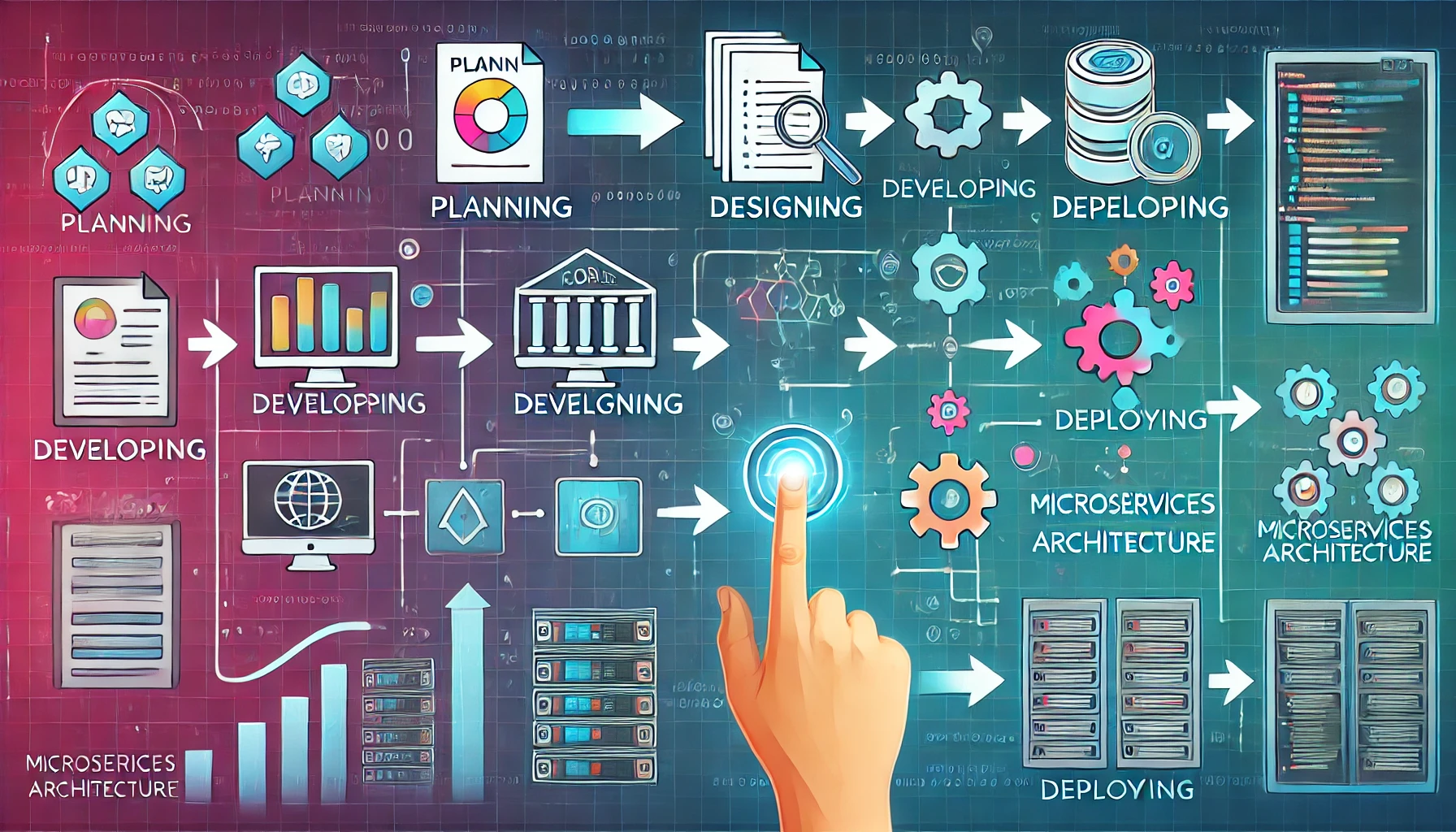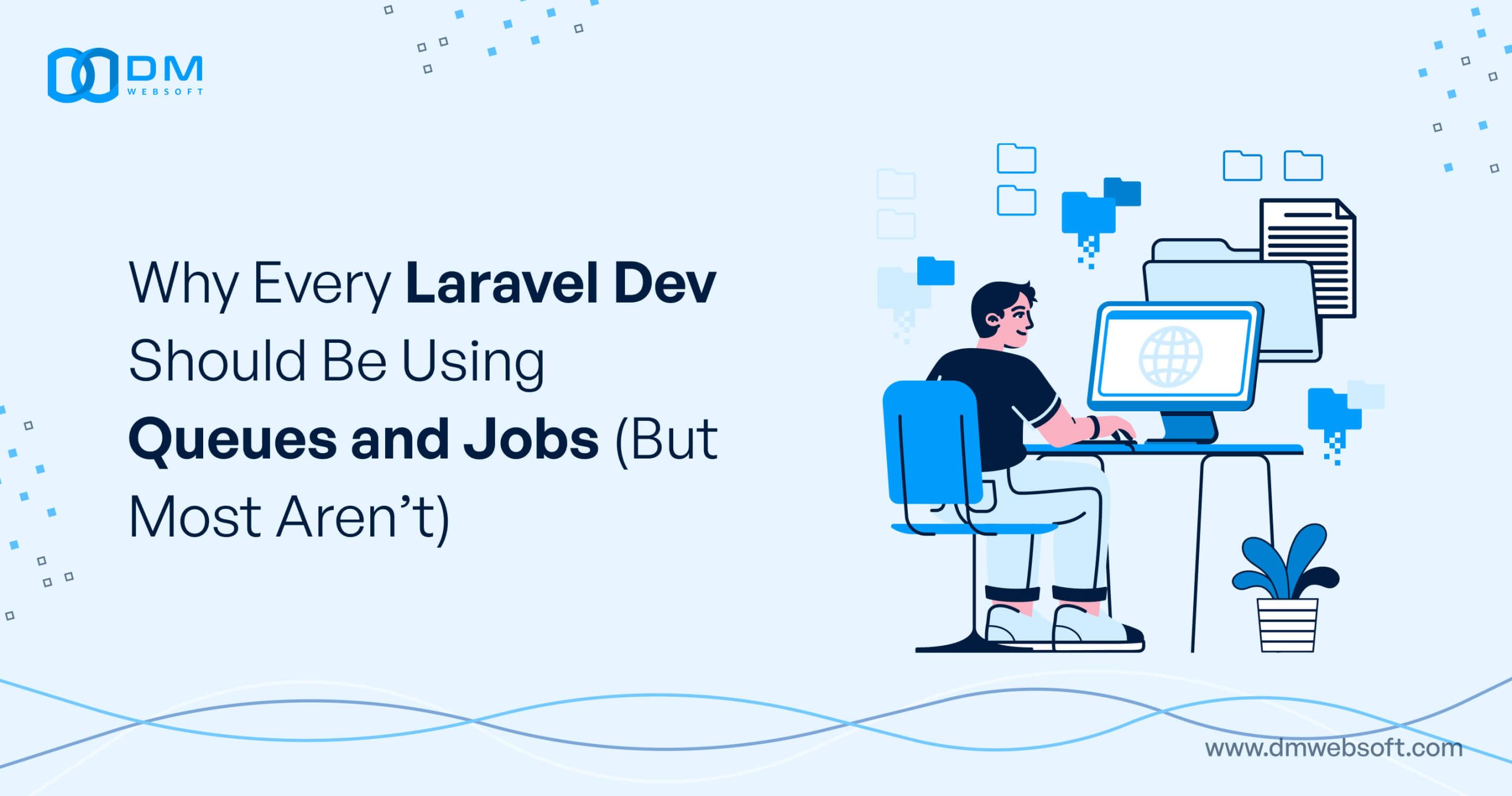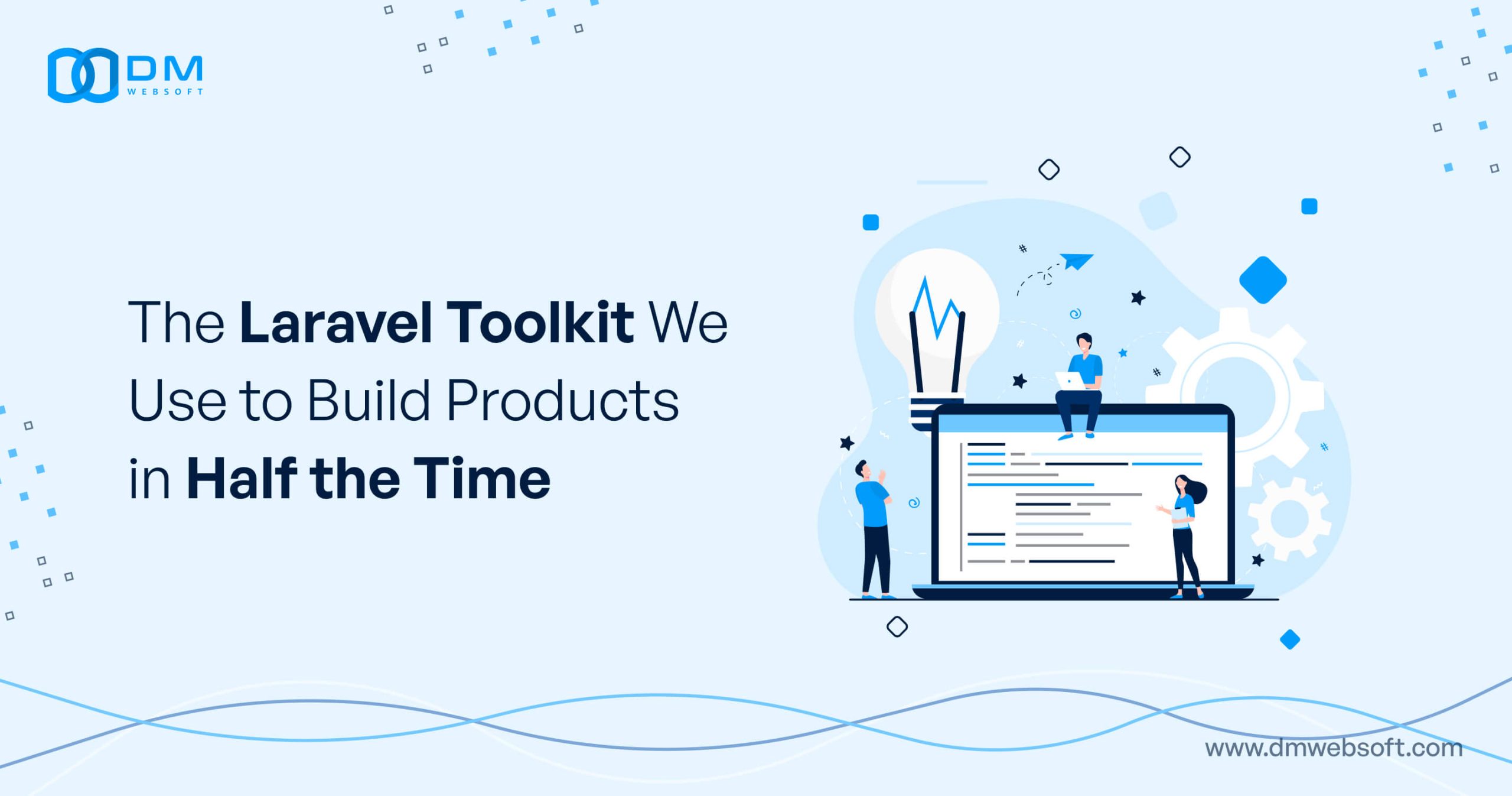DM WebSoft LLP exceeded our expectations! Their seasoned team of experts delivered a website that perfectly captures our brand essence. Their 15+ years of experience truly shine through in their exceptional web development skills.
Microservices Architecture: Building Scalable and Maintainable Web Application

TABLE OF CONTENT
Get in Touch
Introduction

In a fast-evolving digital world, businesses have always been looking forward to ways through which they could build scalable web applications that would grow along with their user base, while performing well and with high reliability. That’s where a microservices architecture comes into play—offering the perfect approach for a complete renovation of web applications, be it in development or deployment. In contrast to classical monolithic architectures, within which all the parts of an application are interwoven and dependent on each other, microservices break it down into small, relatively independent services that can be developed, deployed, and scaled separately.
Microservice architecture isn’t just a trend; it’s a game changer for businesses targeting fast, robust applications. Such an architecture would enable companies to be maximally flexible and resilient in view of their markets’ topmost demands and needs. Other than scaling, the benefits of microservices advance to maintainability because one can make updates or replacement of a single service without disturbance of the whole application.
Among other most important advantages of using microservices is to facilitate scalable web applications. Each microservice can be scaled independently according to its specific workload needs, which guarantees the use of resources is well placed and cost-efficiently achieved.
This is an excellent capacity for businesses growing quickly or with varying demand because they can dynamically adjust their infrastructure without losing any performance. By choosing to work with DM WebSoft LLP, you are teaming up with the kind of people who are dedicated to helping you achieve your business goals in spite of all the complexities that usually follow the concept of microservices.
Microservices Architecture

In the fast-changing scenario of software development, microservices architecture has emerged and challenged the old monolithic patterns. But what exactly are microservices, and why are they so important in the modern scenario of web application development? The approach to designing software systems in the form of a number of independently working service units is termed microservices architecture. Each of these services—or microservices—is hosted in its own runtime process and uses lightweight protocols, usually HTTP/REST, for communication with other services. Microservices architecture is the polar opposite to monolithic architecture, in which all components of an application are tightly bound and run as a single unit.
Key Features of Microservices Architecture:
- Independence: Each microservice is designed to handle a specific business function and can be developed, deployed, and scaled independently. Independence: Resource scaling is easy because you can scale resources for each of your services independently without affecting other services.
- Decentralized Data Management: With monolithic systems, almost all of the services rely on one database. Microservice architecture encourages decentralized data storage. In this architecture, every service manages its database so that the database has high availability, more data integrity, and better optimization in the light of the requirements of their services.
- Flexibility and Agility: Microservices underpin development practices of agility, making it feasible for the teams to work in parallel on different services, thus minimizing development cycles and hastening time-to-market of new features or updates to maintain competitiveness in applications.
- Fault Isolation: Failures within one service are isolated with microservices—by design, they don’t cascade to bring down the whole application. This increases resilience and reduces downtime that could severely hurt customer trust and satisfaction.
- Scalability: Monolithic architectures have issues of scaling up due to the fact that the whole application would have to be multiplied. Microservices can be independently scaled, making them flexible and cost-effective. Deployment is usually done by re-deploying the whole system, including the monolithic application. In contrast, a microservice attains continuous deployment and integration, allowing updates which do not change the whole application in one go.
- Complexity: Monolithic systems can be easily developed in the budding stage because of their single-unit structure, but they become complex as they grow. Although microservices create some complexities in communication and data management, they have gains in other dimensions: flexibility and maintainability. At DM WebSoft LLP, we understand the challenges and opportunities arising in such a migration to the architecture of microservices.
Therefore, we are professionals at how best to help businesses transit through change by building tailor-made solutions that realize the strengths of microservices and respect industry peculiarities.
Make DM WebSoft LLP your partner of trust and get developed scalable and maintainable web applications around your business objectives. Now take the control with microservices that ensure future-proof applications, even when chips are down. Proper expertise and guidance can turn your business on to the full potential of architecture for microservices innovation and growth.
Microservices in Scalability

In today’s digital world, the efficiency of scaling applications is an important concern for a business to stay competitive and respond quickly to customer demand changes. This allows every modular application component to grow independently and hence can assure easily scalable web applications through microservices architecture.
Independent Scaling: One of the key associated features with microservices architecture is the ability to scale services independently. Every microservice can be scaled regarding its unique workload, meaning one is able to allocate resources to the most significant aspects of their business. In simple terms, you are able to scale an important service that has high traffic, such as a payment gateway, without affecting other parts of the application, thereby ensuring economy of resources and cost effectiveness.
Efficient Use of Resources: General scaling of a monolithic system is merely replication of the complete application, and it becomes resource-intensive. However, microservices make it quite easy to scale up only the services that are required at a given time, thereby using servers efficiently and reducing operational costs. This leads to better infrastructure utilization and hence better performance in totality.
Flexible Deployment Strategies: Microservices permit cloud-native architecture that can enable businesses to leverage the powerful cloud of AWS, Google Cloud, and Microsoft Azure, along with their auto-scaling facilities, in dynamically adjusting resources to demand. Microservices can fit seamlessly with these functions, and dynamic scaling and rapid deployment are efficiently carried out in a very solid environment.
Load Balancing and Distributed Systems: It is more common for microservice-based architectures to involve some form of load balancing technique within their distribution mechanism. This not only improves performance, but also through the lack of a bottleneck in any one service, it can make the application more fault-tolerant. Distributed systems further allow for scalability in that microservices can be run across different servers or data centers, thus boosting the redundancy and availability of the system.
Businesses have to be agile, considering the changes in market conditions. This microservice architecture is supported by agility, which helps companies put new features and updates out very quickly. It supports application change assurance, changing with the tastes and preferences of customers while remaining relevant and competitive within fast markets.
The single focus at DM WebSoft LLP is to build scalable web applications with microservice architecture and customization of the same in alignment with business needs. Specializing in building modular, adaptive solutions wherein businesses can affordably grow, we are the place to help enterprises climb their business ladder. We work in close synchronization with our clients, ensuring that applications are designed for scalability from the very beginning to assure rock-solid bases on which future growth and success can be built.
Just take all the advantages that microservices offer to unlock the full potential of your business. Entrust your business to DM WebSoft LLP because we let you have the latest technologies and the best strategies for your scale and innovative solutions. Let us make it for you to build the scalable solutions necessary to thrive in today’s competitive landscape.
Microservices and Maintainability

In this fast-moving world of software development, efficient maintainability of sophisticated applications is pivotal for continued success. Microservices architecture provides a sound framework on which to increase the maintainability of web applications, enabling businesses to implement changes quickly and bring down levels of downtime.
How Microservices Enhance Maintainability
- Isolation of Services and Modularity: The most significant benefit of microservices architecture is the level of modularity it introduces into application development. Each microservice is an independent entity that operates to serve a single function or a business capability. This modular architecture aids in allowing the developers to update a service or a portion of an application without creating an effect on the whole application. It helps in troubleshooting and maintains the complexity of large systems with ease, as problems are mostly localized to a given service.
- CI/CD: The microservice architecture is complemented by CI/CD practices where any code change gets automatically tested and deployed. This further integrates the teams to push out updates fast and reliably, reducing the chances of errors and ensuring that applications are always current. CI/CD pipelines will definitely hasten the development cycles and help businesses maintain a quality codebase that enhances user experience.
- With monolithic architectures: Tracing back the problem can be very cumbersome because of the tight coupling between components. The architecture of microservices really simplifies debugging, as services are isolated and it’s easier to point at a problem in particular. Besides, monitoring tools are quite comprehensive so that the company gets real-time insights into service performance, which supports proactive maintenance and rapid response on potential issues.
- Adaptation to Technological Changes: The software landscape is in dynamic changes all the time; new technologies and frameworks always appear. The flexibility offered by the microservices architecture—in accepting new tools and technologies for single services without a change of the overall application—allows the applications to stay current and employ the latest innovation in offering better functionalities and performances.
- Minimize Technical Debt: With time, technical debt can pile up, complicating application maintenance. Microservices can help to overcome the problem because its structure enables teams to refactor or rewrite parts of the system without disturbance. Incremental development against technical debt helps in keeping a clean codebase with less maintenance overhead, making the business more agile.
At DM WebSoft LLP, we understand that the most important aspect for longevity is the development of maintainable web applications. Our team is committed to making it easy and staying in tune with improvements that come in solutions implemented on the microservice architecture. We take you from setting up maintainable designs to deploying effective monitoring and CI/CD systems for resiliency and adaptability in your applications.
So partner with DM WebSoft LLP and change your practices to more efficiently maintain your software. Building your web applications to be robust and maintainable, they stay that way in the face of challenges tomorrow may bring—thanks to our commitment to both innovation and excellence. Let us help you build a future-proof solution that grows with your business.
Microservices Implementation

Transitioning to microservices is a strategic move in relation to your web applications. It should make them agile, scalable, and maintainable. Microservices implementation should be ideally planned and executed for smooth transitioning and successful adoption. Here are the key steps and points of consideration in implementing microservices architecture:
Transition Steps to Microservices Architecture
- Define Business Capabilities: The most basic step that one needs to go through is finding what the business capability of the application is. Every microservice should be designed to work on specific business functions such as payment processing, user authentication, or inventory management, so services are focused and well-defined with business goals.
- Design Microservice Boundaries: With the definition of business capabilities, a designer needs to create the boundaries for every microservice. This is defining the scope of the services and how they will interact. A well-defined boundary leads to a reduction in dependency between services, making them flexible, independent, and resilient.
- Right Technology Stack: Choose the right technology stack for good microservices. Choose the right programming languages, frameworks, and tools that will best fit your application requirements. For example, Docker is used very widely for containerization, Kubernetes for orchestration, and Spring Boot for developing microservices using Java.
- API Gateways and Communication Protocols: Efficient communication between services lies at the core of the microservices architecture. Implement API gateways to manage service interactions for better performance, security, and efficient communication. Select appropriate protocols—such as HTTP/REST or gRPC—depending on what your application demands in terms of performance.
- CI/CD Practices: Continuous Integration and Deployment are chief means toward a well-aligned development process. Set up automated pipelines to test, build, and deploy services individually for the fastest updates and minimal error risks.
- Monitoring and Logging: You need to have robust monitoring and logging in place to give you insights at runtime about the performance of your microservices. Use tools such as Prometheus, Grafana, and ELK Stack for service metrics, early issue detection, and that your application is reliable.
Key Considerations and Challenges
- Data Management: A key feature in most microservices architecture is data management.
- Consistency: Ensure that your data is consistent and integral with proper management of data among your microservices.
- Security: Microservices should be developed with strong security in mind: authentication, authorization, and encryption of data. Continually analyze your application’s security vulnerabilities and update them to remain secure.
- Cultural Shift: The move toward microservices may entail a change in culture for your company. Encourage and develop collaboration and communication within the team for innovation and continuous improvement.
At DM WebSoft LLP, we specialize in guiding businesses through the complexities of adopting an architecture that involves microservices. Our expertise is demonstrated through close cooperation with clients in developing and implementing solutions over custom-made microservices. From defining service boundaries to setting up CI/CD pipelines, we ensure a seamless transition that optimizes the benefits of microservices.
Work with DM WebSoft LLP to harness the power of microservices and unlock new levels of agility and efficiency. We are committed to excellence and innovation so your applications are future-proofed in the ever-growing digital space. Let us help you get your perfect solution with future-proof capabilities that will let your business thrive.
Business Applications in Industry

Microservices architecture is versatile, transversal, and can be applied with ease in most industries. They have enabled businesses to achieve increased agility, scalability, and innovativeness by applying microservices architectures. The adoption of microservices allows them to align better technology with the business goal, making a more tailored solution in overcoming specific industry challenges. Here’s how microservices are being leveraged for some of the most important sectors:
E-commerce: Enhancing Flexibility and Performance
The e-commerce business has to be a judicious amalgamation of efficiency, smooth user experience, and dealing with an extremely high volume of traffic and transaction loads. Microservices make this architecture possible as they segregate disintegrated applications into autonomous services like a product catalog, payment services, and user authentication.
- Scalable Solutions: Microservices enable the individual scaling of services for e-commerce enterprises, assuring that areas subjected to high demand—for example, checkout processes—will be able to handle this surge during peak shopping periods without negatively impacting other parts of the application.
- Rapid Deployment of Features: An e-commerce platform can add on new features and updates quickly, in accordance with the evolving market trends and changing customer preferences, through the use of microservices, without being tied to a long cycle of development.
Healthcare: Improved Patient Care and Data Management
Managing sensitive patient data with the utmost care goes hand in hand with the healthcare industry. Microservices architecture is able to offer health providers the flexibility and security to effectively deal with such challenges.
- Data Privacy and Security: Microservices allow decentralized data management, enhancing data privacy and reducing the risk of breaches. Each service can enforce specific security measures according to its functions; for example, encryption of patient records or communication between services.
- Enhanced Interoperability: With microservices, a health organization has better interoperability between the systems, easing the process of data exchange and collaboration across different departments and health facilities.
Financial Services: Improved Security and Efficiency
The financial sector needs maximum security and efficiency while ensuring data is kept safely. This means having financial institutions endowed with robust and flexible solutions, something that only a microservice architecture can deliver.
- Real-time Processing: The ability of applications in financial services to respond to transactions in real-time is key for maintaining services fast and accurate for customers. That would be important for services like fraud detection and online payments that require instant responses.
- Compliance and Regulation: Microservices make it easier to be compliant by updating individual services of financial institutions with new regulations, therefore ensuring a reduction in process disruptions and complete compliances with industry standards.
Future Trends and Innovations in Microservices
The scope for innovation and growth expands as more industries keep embracing the microservices architecture. New technology trends, such as serverless computing, edge computing, and AI-driven microservices, have been dramatically changing the ways through which businesses can now embrace new technologies to remain competitive in the marketplace.
- Serverless Computing: Harnessing microservices with serverless computing will benefit businesses in two important ways: reducing infrastructure costs and streamlining operations by focusing on developing and deploying apps, rather than server management.
- AI-Powered Microservices: Artificial intelligence is combined into microservices to potentiate their ability to automate certain processes and to make decisions—resulting in businesses that can offer services personalized and intelligent enough for the customer.
We appreciate the transformative influence of a microservices architecture at DM WebSoft LLP across varied domains. Our team of experts are dedicated to delivering innovative solutions that help businesses harness microservices for superior performance and strategic advantage. No matter whether you are in e-commerce, health, finance, or whatever. We understand microservices problems and how to align behaviors in a way that serves growth engines for you.
Choose DM WebSoft LLP as your partner in innovation and technology. Our dedication to excellence ensures applications designed for the uniqueness of the industries you belong to, putting your business in the lead for success in a dynamic digital landscape.
How DM WebSoft LLP Can Help

In this fast-moving world of digitization, businesses need someone they can depend on to help them sail through the challenges that come with implementing this new microservice architecture. At DM WebSoft LLP, we are known for building scalable and maintainable web applications so that businesses can fulfill their objectives and stay competitive in their chosen markets.
Custom Microservices Development
DM WebSoft LLP brings lots of experience and technical competence to the table in order to make your way into microservices architecture smoother and successful. Our expert developers and architects work closely with you to design and develop bespoke custom microservices solutions according to your unique business needs.
- Tailored Solutions: We clearly understand the fact that each business is unique, and for that reason we offer tailor-made services that are in concert with your strategic imperatives. Our solutions are flexible by design and can be changed with your business changes.
- End-to-End Services: Right from initial consulting and design to development and deployment, we provide comprehensive support throughout the entire process. Our team is dedicated to providing quality solutions that meet your specifications and exceed your expectations.
- Proven Track Record: DM WebSoft LLP has a proven track record in a number of various industries through successful projects which have rewarded it with customer loyalty based on excellence and innovation. We provide results that matter – grown and performance.
- Microservices Architecture Consulting and Implementation: Transition to microservices is tough. But with DM WebSoft LLP as your partner, you will be guided and supported on your way to the top. Our consulting will help you make informed decisions and develop a clear strategy in implementing microservices effectively.
- Strategic Planning: Work together to analyze your existing architecture for the ability to identify the areas of improvement and develop a roadmap towards the transition into microservices. We will work to ensure that the transition is strategic and gives you the assurance that all your business goals are met to the letter with the best ROIs.
- Implementation Expertise: The team delivers high-resilience, efficient, and secure microservice architectures using the latest tools and technologies in the development of systems. We believe in implementing the best practices and following the standards set by the industry so that your applications are built on solid ground.
Some of our proud moments from the successful projects and client testimonials reflect the commitment to client satisfaction that DM WebSoft LLP has at its core. We are proud of the good reviews and testimonials that our clients give us for having come to experience the benefits of our skills and dedication.
- Customer Success Stories: Look through our successful projects to see how we have helped companies like yours reach their goals using innovative microservices solutions.
- Testimonials: Our clients love us for the collaborative approach and hands-on personalizeattention. Listen from them directly how DM WebSoft LLP has made a difference in their journey of digital transformation.
Ready to take the future of web development to the next level with a microservices architecture? Get in touch with DM WebSoft LLP to unlock the full potential of your applications and take your business to new heights. Our team of professionals will assist you at every step, providing you with all the tools and knowledge needed to be successful.
Reach out to us today to learn more about our services and to enable us to provide you with scalable, maintainable, and innovative solutions that meet the demands of a swiftly changing digital world. Let DM WebSoft LLP be your trusted partner in technology and innovation.
Conclusion
Today’s business is facing increased pressure to develop web applications that scale and are maintainable as the digital world evolves. Microservices architecture thus offers one of the ways to do this by increasing flexibility, performance, and resilience. By decomposing applications into smaller and loosely coupled services, microservices allow for rapid development and therefore provide businesses with a chance to quickly adjust in case there are fluctuations in the market or changes in customer needs.
Throughout this blog, we have seen the resourcefulness of the microservices architecture that brings dynamism in scaling and provides better maintainability through practices such as modular design and CI/CD. We’ve also outlined in this reshaping of the most fundamental e-commerce, health, and finance industries with tailor-made solutions that attend to particular problems and unlock opportunities for further growth.
Migrating to a microservices architecture is challenging, but businesses will be able to chart their way through with the right strategy and expertise in place. At DM WebSoft LLP, we spend our time providing solutions for our clients so that they can easily harness the power of microservices as real business value to their companies.
Select DM WebSoft LLP as your partner in the same way you would choose a team of dedicated experts in their field. Our experience in the industry, personal approach, and commitment to quality will guarantee that your applications are made to cope with challenges from today, and tomorrow on top. Whether you need to improve an existing system or design an application from scratch, we have the skills and experience in guiding you every step of the way.
Microservices architecture is an important enabler of the incredible value that this approach can bring to agility and efficiency. DM WebSoft LLP—the help you need to transform your ideas into stout, scalable, and maintainable web applications that power your business to the top of its game in this digital world.
Reach out to us today in order to learn more about the ways we can be of help toward realizing your goals. Let’s work together on our innovative solutions that drive your business forward, making sure you succeed in this ever-changing digital landscape.
Microservices architecture is a design approach where applications are structured as a collection of small, independent services that communicate with each other.
Microservices allow individual services to be scaled independently, optimizing resource usage and improving application performance.
Microservices improve maintainability by isolating services, allowing updates without affecting the entire application and facilitating easier debugging.
Industries such as e-commerce, healthcare, and finance benefit greatly from microservices due to their need for flexibility, performance, and security.
DM WebSoft LLP provides end-to-end microservices solutions, from consulting and design to development and deployment, tailored to your business needs.
Get Started Now !
What’s the Process ?
Request a Call
Consultation Meeting
Crafting a Tailored Proposal
Get Started Now !
Real Stories, Real Results. Discover What Our Clients Say

Working with DM WebSoft LLP was a game-changer for our business. Their technical prowess and innovative solutions transformed our online presence. A highly recommended web development agency with a stellar track record.

We are thrilled with the results DM WebSoft LLP delivered. Their deep understanding of web development coupled with years of expertise ensured a seamless and visually stunning website. True professionals!

In a digital age where first impressions matter, DM WebSoft LLP crafted a website that speaks volumes. The team’s attention to detail and commitment to quality set them apart. Thank you for making our vision a reality.

DM WebSoft LLP’s team demonstrated unparalleled expertise. Their ability to navigate complex technical challenges with ease is truly commendable. Choosing them for our web development needs was the best decision.

Exceptional service, unmatched skills! DM WebSoft LLP stands out as a leading web development agency. Their collaborative approach and commitment to excellence make them our go-to partner for all things web-related.

DM WebSoft LLP turned our ideas into a digital masterpiece. The seamless communication and timely delivery of our project showcased their professionalism. Highly impressed with the level of creativity and skill.

Our experience with DM WebSoft LLP was nothing short of amazing. From concept to execution, their team provided top-notch web development services. A reliable partner for businesses looking to elevate their online presence.

DM WebSoft LLP’s team of tech experts is second to none. Their wealth of experience reflects in the quality of their work. Our website not only meets but exceeds industry standards, thanks to their dedication.

Choosing DM WebSoft LLP was the best investment for our web development needs. Their team’s proficiency, coupled with a customer-centric approach, made the entire process smooth and enjoyable. A pleasure to work with!



